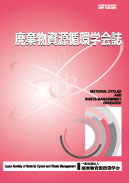Volume 24, Issue 2
Displaying 1-9 of 9 articles from this issue
- |<
- <
- 1
- >
- >|
Preface
-
2013Volume 24Issue 2 Pages 115-116
Published: March 31, 2013
Released on J-STAGE: March 19, 2021
Download PDF (225K)
Special Issues : Recent PRTR Relating Issues in Waste Management
-
2013Volume 24Issue 2 Pages 117-122
Published: March 31, 2013
Released on J-STAGE: March 19, 2021
Download PDF (694K) -
2013Volume 24Issue 2 Pages 123-128
Published: March 31, 2013
Released on J-STAGE: March 19, 2021
Download PDF (449K) -
2013Volume 24Issue 2 Pages 129-134
Published: March 31, 2013
Released on J-STAGE: March 19, 2021
Download PDF (413K) -
2013Volume 24Issue 2 Pages 135-143
Published: March 31, 2013
Released on J-STAGE: March 19, 2021
Download PDF (758K) -
2013Volume 24Issue 2 Pages 144-152
Published: March 31, 2013
Released on J-STAGE: March 19, 2021
Download PDF (317K)
Introductory Course / Introduction of Physics and Chemistry for Material Cycles and Waste Management 1 :
-
2013Volume 24Issue 2 Pages 153-159
Published: March 31, 2013
Released on J-STAGE: March 19, 2021
Download PDF (772K)
Activity Reports from the Regional Chapters
-
2013Volume 24Issue 2 Pages 160-162
Published: March 31, 2013
Released on J-STAGE: March 19, 2021
Download PDF (582K)
Book Review
-
2013Volume 24Issue 2 Pages 163-164
Published: March 31, 2013
Released on J-STAGE: March 19, 2021
Download PDF (184K)
- |<
- <
- 1
- >
- >|
